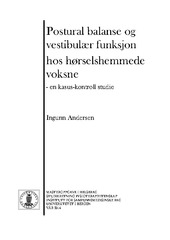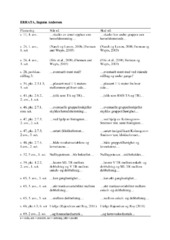| dc.contributor.author | Andersen, Ingunn | en_US |
| dc.date.accessioned | 2014-06-18T09:27:37Z | |
| dc.date.available | 2014-06-18T09:27:37Z | |
| dc.date.issued | 2014-03-31 | eng |
| dc.date.submitted | 2014-03-31 | eng |
| dc.identifier.uri | https://hdl.handle.net/1956/7981 | |
| dc.description.abstract | Background: There are indications that some hearing-impaired individuals have decreased postural balance compared with normal hearing individuals. This balance impairment can be due to damage of the vestibular system. The aim of the study was to: 1) compare the postural balance between a group of hearing-impaired and a group of normal hearing adults, in standing position and while walking; 2) Examine the vestibular function in the hearing-impaired individuals; 3) Evaluate which sensory system the hearing-impaired compensated the most with. Materials and methods: In this case-control study, the postural balance in 17 hearingimpaired individuals was (mean age 39 years) compared with 14 normal hearing individuals (mean age 34 years). The groups’ balance was examined in standing position and while walking under baseline conditions, and by manipulation of the somatosensory and/or visual system. A kinematic sensor was placed over the lumbar spine to measure trunk regularity (during walking), and RMS trunk acceleration (while standing and walking). In addition, measurements have been made of the groups walking speed. The vestibular system in the hearing-impaired was evaluated by clinical tests. Results/conclusion: The hearing-impaired individuals have slightly reduced postural balance compared to the control group. This was demonstrated by increased RMS trunk acceleration in all tests in standing with somatosensory manipulation, reduced preferred walking speed and decreased trunk regularity while walking. The vestibular examination showed that two thirds of the hearing-impaired group had damage of the vestibular system. The study indicates that hearing-impaired adults are more dependent on the somatosensory system than the visual to compensate for the vestibular loss in standing. The study could not conclude if the same connection can be made for walking. | en_US |
| dc.description.abstract | Bakgrunn: Det foreligger indikasjoner på at hørselshemmede individer har nedsatt postural balanse sammenlignet med normalthørende. Den nedsatte balanseevnen kan skyldes samtidig skade av det vestibulære systemet. Studiens hensikt var å øke kunnskapen om forholdet mellom hørselshemming, vestibulær funksjon og postural balanse. Dette ble forsøkt ved å; 1) Sammenligne posturale balansen i stående stilling og under gange hos en gruppe hørselshemmede og normalthørende voksne; 2) Undersøke de hørselshemmedes vestibulære funksjon; 3) Evaluere hvilket sensorisk system de hørselshemmede kompenserte mest med. Materiale og metode: I denne kasus-kontroll studien ble den posturale balansen hos 17 hørselshemmede (gjennomsnittlig alder: 39 år) sammenlignet med 14 normalthørende (gjennomsnittlig alder: 34 år). Gruppenes balanse ble undersøkt i stående og under gange ved basisforhold, samt ved manipulering av det somatosensoriske og/eller det visuelle systemet. Kinematisk sensor over lumbalcolumna ble benyttet for å måle trunkusregularitet under gange, samt RMS trunkusakselerasjon i både stående stilling og under gange. I tillegg ble det foretatt målinger av gruppenes ganghastighet. De hørselshemmedes vestibulære system ble undersøkt med kliniske tester. Resultater/konklusjon: De hørselshemmede har noe redusert postural balanse sammenlignet med kontrollgruppen, demonstrert som økt RMS trunkusakselerasjon i stående ved alle testene med somatosensorisk manipulering, redusert foretrukket ganghastighet og økt trunkusregularitet under gange. Den vestibulære undersøkelsen viste at 2/3 av den hørselshemmede gruppen har nedsatt funksjon av det vestibulære systemet. Studien indikerer at hørselshemmede voksne er mer avhengig av det somatosensoriske systemet enn det visuelle for å kompensere for det vestibulære tapet i stående, mens under gange er dette forholdet enda uavklart. | en_US |
| dc.format.extent | 8719182 bytes | eng |
| dc.format.mimetype | application/pdf | eng |
| dc.language.iso | nob | eng |
| dc.publisher | The University of Bergen | eng |
| dc.subject | Hørselshemming | eng |
| dc.subject | Postural balanse | eng |
| dc.subject | Vestibulær funksjon | eng |
| dc.subject | Kinematiske sensorer | eng |
| dc.subject | Systemtilnærming | eng |
| dc.title | Postural balanse og vestibulær funksjon hos hørselshemmede voksne - en kasus-kontroll studie | en_US |
| dc.type | Master thesis | |
| dc.rights.holder | Copyright the author. All rights reserved | |
| dc.description.degree | Master i Fysioterapivitenskap | |
| dc.description.localcode | MAMD-FYST | |
| dc.description.localcode | FYSTD395 | |
| dc.subject.nus | 761901 | eng |
| fs.subjectcode | FYSTD395 | |

